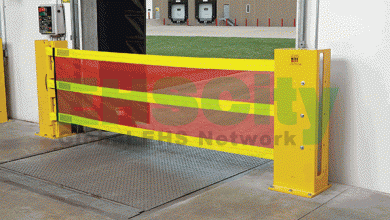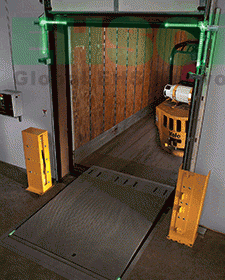Unfortunately, injuries and fatalities can and do happen on loading docks every year. Some of the most common causes of dock accidents involve the semi-trailer leaving the dock unexpectedly, which can result in the lift truck falling to the ground. Common causes of dock accidents include early departure, when a truck driver mistakenly drives away while a lift-truck operator is entering, leaving or still inside the trailer. Another cause is trailer creep. A trailer can move substantially under the weight of a lift truck entering and exiting a trailer.
Landing-gear collapse is another cause of dock accidents. Weak or damaged landing gear gives way, causing the trailer to pitch forward or to the side. Trailer pop-up, another cause, occurs when the weight of a forklift entering the rear of the trailer causes it to move forward and drop, causing the nose of the trailer to suddenly rise. Similarly, trailer upending, when the weight of the forklift sends the trailer's nose down, causes the rear end to move up and away from the building.
Forklift operators also may experience "dock shock," which is pain or spine injury resulting from long-term, repetitive vibrations. It can occur as operators enter and leave trailer beds via a leveler.
A Strategy for Safety
Having a systematic safety strategy in place can help reduce the potential for these kinds of onsite accidents and conditions. A loading-dock safety strategy can make your site a healthier place to work. A systematic approach that integrates a variety of products can help you achieve your safety goals.
When used with other safety equipment and procedures, you can create built-in safety checks simply by adhering to a specific order of operations. Your system might be as basic as following an ordered checklist when using equipment. Or you might choose equipment that interlocks or interconnects with other dock-safety components, ensuring that each step in your process is safely completed before beginning the next.
Before implementing a system, consider how you will address these four factors at your site:
- Restraining the trailer.
- Communicating the status of the restraint to drivers and forklift operators.
- Protecting open docks.
- Creating a smooth transition from floor to trailer bed.
Restraining the Trailer
There are several options available for securing trailers at the loading dock. Industrial wheel chocks, wheel-based restraints and automated restraint equipment are among the most common.
While wheel chocks provide some level of protection, they still can leave workers vulnerable in the event that a trailer lurches or its gear collapses. In icy or snowy conditions, they can slip, or they simply can become damaged over time.
Wheel-based restraints offer flexibility because they can accommodate several types of trailers. These restraints, commonly mounted to the dock approach, engage with a rear tire of the trailer and prevent it from moving forward.
Another option is the automated restraint. From its mount on the outside wall beneath the dock's opening, a hook automatically extends and wraps around the rear-impact guard (RIG) on a trailer, which secures the truck and stops any forward movement. Some also work with intermodal or international trailers, which might not have RIGs. When considering this option, look for a model that offers a wide range of vertical engagement (ideally between 9 and 30 inches), and that can secure trailers equipped with RIGs as well as intermodal trailers.
Communication, Inside and Out
Any communication system that offers a quick visual read to drivers and your employees will help ensure that everyone is on the same page.
A standard wall box with green and red lights tells drivers whether it's safe to approach the dock, and lets workers inside know when they may approach the trailer.
Some lighted communications systems go beyond the box. In addition to the control-box lights, lighting is placed near the top of the dock opening, as well as along the sides of the leveler on the floor. It provides safety information at-a-glance to the forklift operator, whether he or she is inside the building or inside the trailer.
Protecting Open Doors
An open dock can present a hazard to employees and could even compromise supply chain integrity if, for instance, your facility is involved in shipping food products. Dock barrier systems and dock shelters can reduce these risks.
A dock barrier provides a visual cue for employees that the loading dock is open but a truck is not present. If you plan on making a dock barrier part of your safety strategy, look for one that can withstand the weight of a moving, loaded forklift.
A dock shelter that goes around the dock opening closes any gaps that might exist between the trailer's edge and the door. It keeps debris such as leaves or snow from getting into your facility or the truck bed, and it keeps the temperature constant. That's particularly important if you're working with refrigerated goods during the warm summer months. Additionally, dock shelters eliminate the exchange of inside and outside air, which reduces the chances that equipment or goods will be damaged. A dock shelter with a complete, four-sided seal will be the most effective option.
Creating a Smooth Transition
You might not think of back pain as a repetitive-motion injury. But when it comes to the effects of "dock shock," that's exactly what it is.
When a forklift operator enters and exits a trailer via a leveler, he or she experiences a series of jolts and joint shocks several times a day. Over time, it can lead to chronic back pain or spine injury, along with lost wages and reduced productivity.
Not all levelers are the same, however. Look for a model that provides a smooth transition. It will be more likely to protect your employees' health while reducing wear and tear on your equipment.
Consider Expert Assessment
The equipment and configuration options can seem overwhelming. Consider bringing in a loading-dock safety-systems expert to help you assess your operation and determine which options will work best for your situation. He or she will need to know the answers to the following questions:
- What types of trailers are coming to your loading dock?
- What is your current system for securing them?
- What is your current communication system?
- How is the dock currently secured?
Then, with an understanding of your sequence of operations, the loading-dock safety-systems expert will be able to determine your risks and recommend improvements to both your equipment and process.
When you have components that work together with your process, you'll have a fully customized, systematic safety strategy that can help reduce loading-dock dangers.
Walt Swietlik is director of customer relations and sales support at Rite-Hite Corp.



